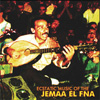
In keeping with Sublime Frequencies' lengthy tradition of unearthing bizarre and amazing music that I didn’t even know existed, guerrilla ethnomusicologist Hisham Mayet’s latest offering delves into the raucous nightlife of Marrakech’s legendary open-air marketplace  Managing to talk his way through a longstanding ban on the close recording of performers, Mayet captures the raw power of three of Jemaa El Fna’s most compelling acts as they blast though blistering, electrified renditions of classic Moroccan pop using homemade rigs of car batteries and megaphone speakers.
Jemaa El-Fna has many possible translations, all of them very enigmatic and somewhat sinister: The Mosque at the End of the World, Rendezvous of the Dead, Place of the Vanished Mosque, Mosque of Annihilation, and several other equally colorful possibilities.More concretely, it is a large central square in the "old city" section of Marrakech that is one of the weirder and wilder marketplaces on earth.By day, it is populated by an eclectic and tourist-friendly array of snake charmers, orange juice and water vendors, tarot card readers, numerologists, trained Barbary apes, henna tattooists, and herbal potion vendors.And a single and very anachronistic dentist.Once the sun goes down, however, the square undergoes a complete transformation into something much more vibrant, unhinged, and packed with natives.All the daytime vendors disappear, and the market gradually fills with an wide array of food stalls, magicians, acrobats, storytellers, dancing transvestites, and (of course) street musicians.
The three groups that Hisham recorded are ostensibly "cover bands," as their repertoire is composed mostly of work by ‘70s/’80s protest/folk groups like Lemchaheb and Nass El Ghiwane (whom Martin Scorscese once called "the Rolling Stones of Africa").Notably, however, the original pieces are rendered almost unrecognizable by the volume, energy, and passion needed to grab (and hold) the attention of a bustling square filled with people (and competing musicians).This is a very "punk" take on the Moroccan musical canon, filled with violent twangs, wah-wah-pedaled banjos, overdriven amplifiers, furious picking, and explosive percussion.The more sparse moments, like "Tal Riabak Arzali" by solo oud player Mustapha Mahjoub, tend to be the most satisfying from a purely musical standpoint, but it is the more furious percussion blow-outs like Troupe Majidi’s "Khoudrini" that probably best capture the boisterous intensity of the scene.
Naturally, given that this album was recorded in a crowded public square and that the musicians are playing through ramshackle and hopelessly overwhelmed amplifiers, the sound quality is quite raw.As a consequence, pretty much all of the subtleties of the much tamer original artists’ works (which are well-worth checking out) are lost, but it doesn’t matter at all.These recordings are a different animal altogether. Ecstatic Music of The Jemaa El Fna has its sights set on something a bit more difficult than simply immortalizing fiery, innovative takes on some great music—it aims to immerse the listener in an atmosphere that is wholly exotic, rapturous, unique, and gloriously alive (and succeeds as well as could possibly be hoped). Mayet has put together an undeniably exciting and very immediate album (and one that has turned me onto to some very cool Moroccan music), but Ecstatic Music works even better at planting the seeds for an overwhelming compulsion to hop on a plane to Marrakech immediately.
Samples:
- Amal Saha- Lahmami
- Mustapha Mahjoub- Tal Raibak Arzali
- Troupe Majidi- Essiniya
 
Read More

